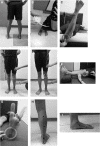Prevalence and risk factor analysis of lower extremity abnormal alignment characteristics among rice farmers
- PMID: 26124645
- PMCID: PMC4476481
- DOI: 10.2147/PPA.S81898
Prevalence and risk factor analysis of lower extremity abnormal alignment characteristics among rice farmers
Abstract
Background: Rice farming activities involve prolonged manual work and human-machine interaction. Prolonged farming risk-exposure may result in lower limb malalignment. This malalignment may increase the risk of lower extremity injury and physical disabilities. However, the prevalence and factors associated with lower extremity malalignment have not yet been reported. This study aimed to investigate the prevalence and risk factors of lower extremity malalignment among rice farmers.
Methods: A cross-sectional survey was conducted with 249 rice farmers. Lower extremity alignment assessment included: pelvic tilt angle, limb length equality, femoral torsion, quadriceps (Q) angle, tibiofemoral angle, genu recurvatum, rearfoot angle, and medial longitudinal arch angle. Descriptive statistics were used to analyze participant characteristics and prevalence of lower extremity malalignment. Logistic regression analysis was used to identify risk factors.
Results: The highest prevalence of lower extremity malalignment was foot pronation (36.14%), followed by the abnormal Q angle (34.94%), tibiofemoral angle (31.73%), pelvic tilt angle (30.52%), femoral antetorsion (28.11%), limb length inequality (22.49%), tibial torsion (21.29%), and genu recurvatum (11.24%). In females, the risk factors were abnormal Q angle, tibiofemoral angle, and genu recurvatum. Being overweight was a risk factor for abnormal pelvic tilt angle, Q angle, and tibiofemoral angle. Age was a risk factor for limb length inequality. Years of farming were a major risk factor for abnormal Q angle, tibiofemoral angle, and foot malalignment.
Conclusion: Prevalence of lower extremity malalignment was reported in this study. Female sex, being overweight, and years of farming were major risk factors for lower extremity malalignment. Lower extremity screening should assist in the identification of foot and knee malalignment in rice farmers. This may then lead to early prevention of musculoskeletal disorders arising from such malalignment.
Keywords: lower extremity malalignment; prevalence; rice farmer; risk factors.
Figures


References
-
- Thai Rice Exporters Association Rice Export Quantity and Value: 2014. [Accessed January 29, 2014]. Online sources 2014 [cited January 28, 2015]. Available from: http://www.thairiceexporters.or.th/statistic_2014.html.
-
- Mokkamul P. Ethnobotanical study of rice growing process in northeastern Thailand. Ethnobotany Res Appl. 2006;4:213–222.
-
- Swangnetr M, Kaber D, Puntumetakul R, Gross MT. Ergonomics-related risk identification and pain analysis for farmers involved in rice field preparation. Work. 2014;49(1):63–71. - PubMed
-
- Puntumetakul R, Siritaratiwat W, Boonprakob Y, Puntumetakul M. Prevalence of musculoskeletal disorder in farmer: case study in Sila, Muang Khon Kaen, Khon Kaen Province. J Med Tech Phys Ther. 2011;23:298–303.
LinkOut - more resources
Full Text Sources

